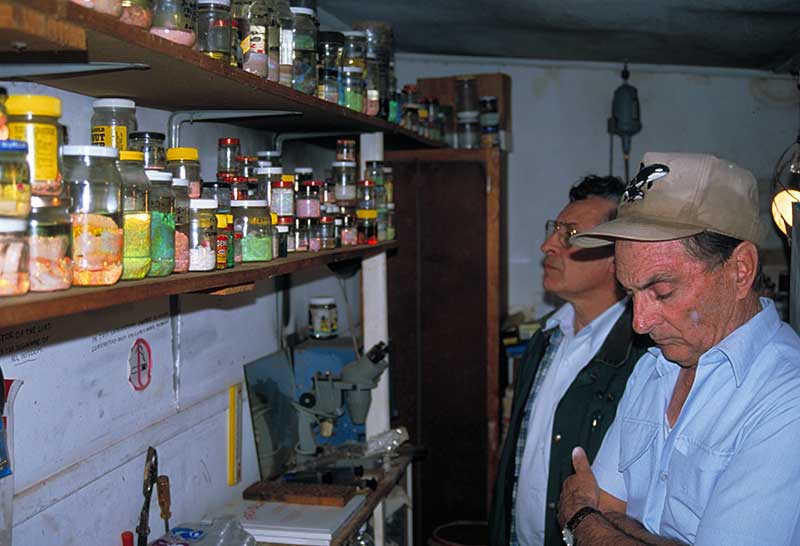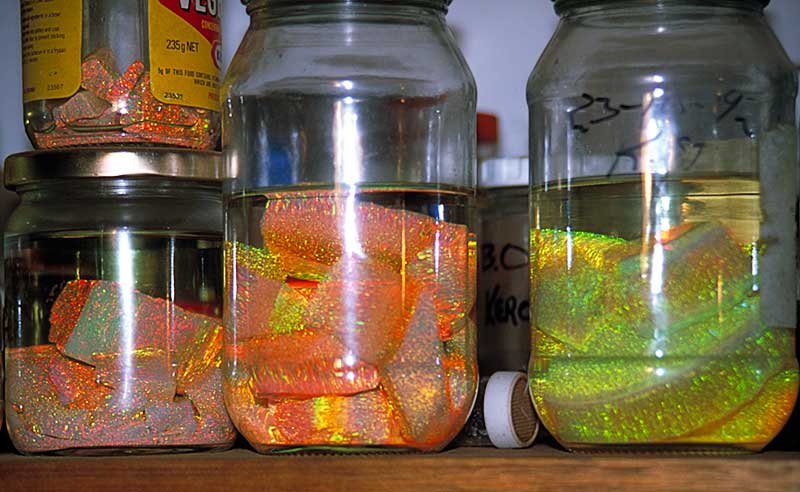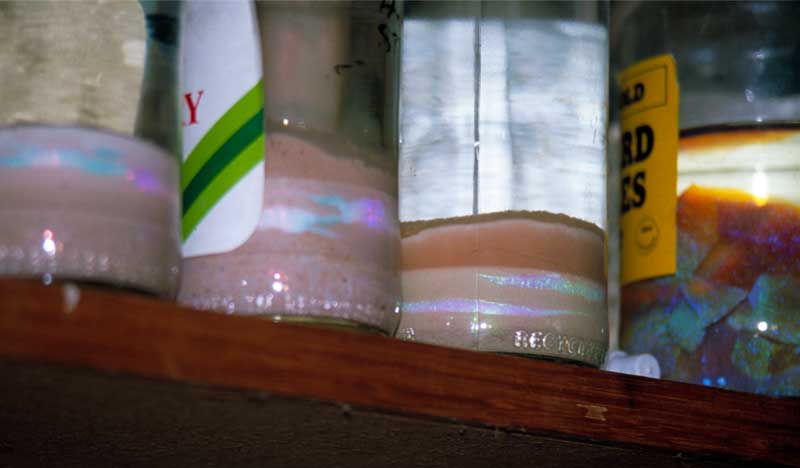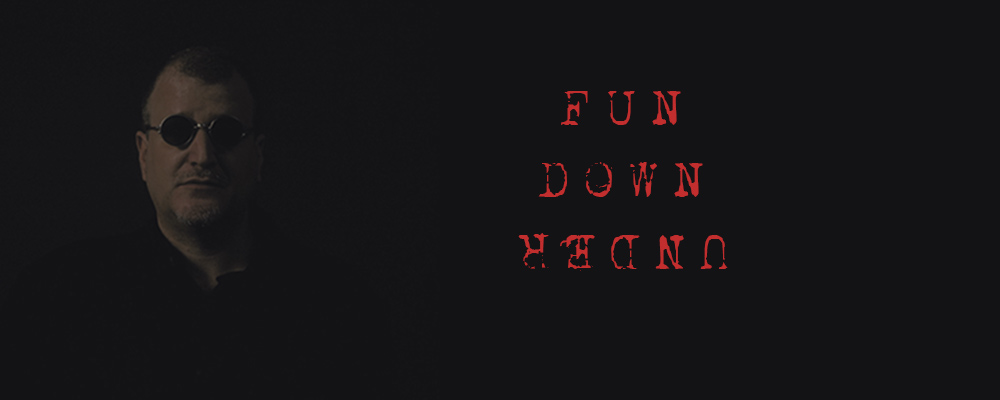Digital Devil #7. The believe-it-or-not story of Australia's Lenny Cram and his opal mine in a mason jar.
Digital Devil #7 • Fun Down Under
Any of you ever visit Australia? I had the chance in 1998. What a piece of work that place is. Something about continuously spinning upside down must scramble the brains. Just look at it. Animals with pouches, birds that can't fly and a version of English that makes translation into Yank-speak more of a challenge than the human genome project. The national gem? It's green, er… red… uh… orange… hmm… blue… ah… keep the bloody thing still, will ya!
And if this weren't enough, the country's landmark is an opera house. An o-pee-ra house, mate! Will all those who have actually heard an Australian opera, please stand, raise your stubby aloft and repeat after me: "Fair go, ya' bastaaard."So, there you have it – an upside-down world populated by an upside-down people. And that, my friends, leads to more craziness than burning a piece of red, white and blue cloth in front of an American Republican (down boy, it's just an Australian flag).
Decisions, decisions
Anyhow, get comfy so I can tell you a little story from the Land Down Under. It's an opal story, but one with lessons for all of us.
Opal was first synthesized a long long time ago, pre-Beowulf. I think the year was 1963. Those that brought us the first synthetic opal were the same group of test-tube jockeys that figured out just what makes an opal show its marvelous play-of-color.
Now flash forward a bit, to a Lightning Ridge miner. Lenny Cram doesn't have any high falutin' scientific training nor any bomb-science laboratory, just a love for opal and a workshed out back. But he's got ideas, ideas on opals and ideas on how they form – ideas having their germ deep in the ground. So he busies himself with jar after jar of experiments. Years go by, and the jars multiply, each with opal growing in it. Eventually word gets out, back to the lab boys who originally developed the process for synthetic opal. They sniff a patent violation and come calling. But what they see in that back shed is brand new. No patent violation here. They leave him be.
 Lenny Cram (far right) and Terry Coldham in Lenny Cram's shed outside his house in Lightning Ridge, Australia.
Lenny Cram (far right) and Terry Coldham in Lenny Cram's shed outside his house in Lightning Ridge, Australia.
 Cram's original experiments resulted in opal quite similar to other synthetic opals. Photo: R.W. Hughes
Cram's original experiments resulted in opal quite similar to other synthetic opals. Photo: R.W. Hughes
Lenny Cram continues his experiments. And he has some luck. Produces jar after jar of artificial opal. But he's still not happy. Something about the stuff is not real enough. So he keeps tinkering, trying to unlock the secret of how opal really grows in the ground. By the time I visited him in May 1998, he had opal growing in jars just as it does in nature, black crystal, white, seams in dirt, even Yowah Nuts. An incredible sight.
 As is clear in the picture above, irregular seams of opal are morphing out of a sand mixture. Photo: R.W. Hughes
As is clear in the picture above, irregular seams of opal are morphing out of a sand mixture. Photo: R.W. Hughes
R-E-S-P-E-C-T
Have any of you ever dug a great big hole in order to find an itty-bitty piece of stone? I must confess I have not. Just thinking about it gets me exhausted quicker than Bill Clinton at a White House intern orientation. But I have empathy for those that do. The thing about digging in the ground is that it gives you plenty of time to think. Spade by spade, shovel by shovel, one bucket at a time. You get a real close look what you are digging for. You also develop an appreciation for it. You begin to understand the pain and labor to bring something up just so that, as Pliny once said, "one finger might shine."
Lenny Cram has respect for the stone he has spent his entire life seeking. When I saw what he had done, I asked the most natural question: "What are you planning to do with your home-grown opals." Lenny just looked me straight in the eye and said "Nothing." And after helping roll my tongue back into my throat, he explained why. He believes his stones cannot be identified. Rather than commercially producing a product that could destroy his industry, he would rather devote the rest of his life to building it up. Which he is doing. 1998 saw Len Cram complete the first volume of a multi-volume work on the history of Australia's opal mines. It's called A Journey With Colour. I could suggest an alternative title. Try R-E-S-P-E-C-T.
Those who know me understand I shed no tears for De Beers. The simple idea of one company owning over 80% of the diamond business gets my blood boiling quicker than a Bill Gates weep session on how tough the competition is nowadays. But I gotta give the South African monopoly credit for their approach to the new Pegasus (HPHT) diamonds developed by GE/Lazare Kaplan. In between gulps of diamond crow, they quietly admitted that they had known about techniques to alter the color of diamonds for over 20 year. Yep, they knew how to do this, but chose to sit on a potential goldmine. Contrast this with General Electric and Lazare Kaplan, whose public statements have suggested that they are doing what they are doing for the excellent reason that, if they don't, someone else will.
Culture
Before I let you go, let me tell you one more Aussie story. The folks Down Under certainly are a cultured lot – why even the cabbies have something to say. On a ride to Melbourne's airport, my driver started talking about Henry David Thoreau, and mentioned the following tale: In 1845, Thoreau refused to pay his taxes, stating he could not in good conscience support a government that allowed slavery (among other things). So the powers-that-be in the Land of the Free threw his ass in jail. While there, his good friend, the writer Ralph Waldo Emerson, came to pay him a visit. Spying Thoreau sitting quietly in his cell, Emerson moaned: "David, what are you doing in there?" Looking him dead in the eye, Thoreau answered: "Waldo, what are you doing out there?"
Inside out
In this business, enhancements are creating more mischief than ever before. Me thinks it's time for those developing such enhancements to take responsibility for the havoc they wreak. The fact that they are enhancing "precious stones" means they have opted to be part of the "precious stone" industry. So they should begin to behave like it.
When a company develops an industry-crippling treatment such as the Pegasus (HPHT) diamond, that company has a responsibility to assist in its identification, to help preserve the very business it is taking part in. And if they can't figure out how to do it? Then they need to give others enough information to have a fighting chance. In the Pegasus case, that means providing major gemological institutes with before-and-after samples, before they begin selling material onto the market. Anything less suggests that GE/LKI's only purpose is to make money, at the expense of the very product they are selling. And at the expense of everyone else in this business.
It's gut-check time for our industry. We've already lost the war with colored stones. But it doesn't have to be that way for diamonds. I'm in here. What are you doing out there?

Acknowledgments
The author would like to extend his thanks to all the fine folks Down Under, who showed off their lovely country with some of the finest hospitality I've ever seen. Too many to name, but in particular, Terry Coldham, who was my host for much of my trip.
Author's afterword
Published in GemKey Magazine (1999, Vol. 2, No. 1, Nov.–Dec.), this was installment #7 of my Digital Devil column. Sadly some have dismissed what Cram has done because of his religious beliefs (he is a creationist). Frankly, even if he believes the moon is made of cheese, it does nothing to diminish his work on understanding how opal forms in the ground.
About the author
Richard W. Hughes is one of the world’s foremost experts on ruby and sapphire. The author of several books and over 170 articles, his writings and photographs have appeared in a diverse range of publications, and he has received numerous industry awards. Co-winner of the 2004 Edward J. Gübelin Most Valuable Article Award from Gems & Gemology magazine, the following year he was awarded a Richard T. Liddicoat Journalism Award from the American Gem Society. In 2010, he received the Antonio C. Bonanno Award for Excellence in Gemology from the Accredited Gemologists Association. The Association Française de Gemmologie (AFG) in 2013 named Richard as one of the fifty most important figures that have shaped the history of gems since antiquity. In 2016, Richard was awarded a visiting professorship at Shanghai's Tongji University. 2017 saw the publication of Richard's Ruby & Sapphire: A Gemologist's Guide, arguably the most complete book ever published on a single gem species and the culmination of nearly four decades of work in gemology.
A reader comment
7 Oct., 1999
Dear Richard,
G'Day Dick, Ow are ya me old China? Fair dinkum mate, yer column in GemKey ['Fun Down Under'] really takes the cake. Just as well our Aussies have got the well known laid-back sense of humour or next time yer was up the Ridge yer might have got a bunch of fives. Lay off the accent bit, Dick. You reckon our accent is funny – strewth mate when we get a Yank in the shop they generally need an interpreter. Californian English is OK, but Deep South may as well be another language. Perhaps it is! Glad you enjoyed meeting Len Cram – one of our living legends out in the bush, indeed in our industry. The world needs more like Len to keep us all sane and bring a bit of reality to the planet.
Cheers mate,
John Tapner, Sydney
